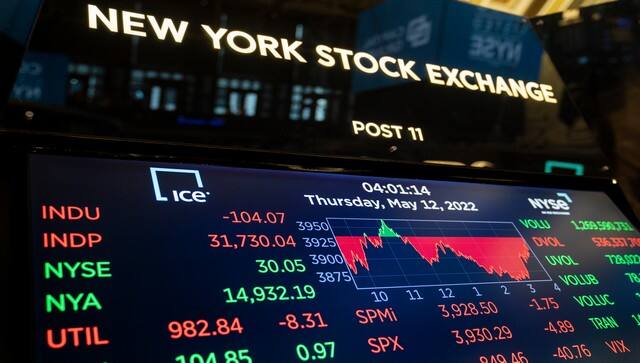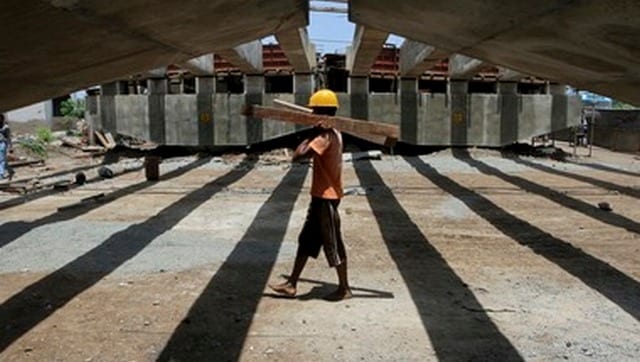Finance minister Nirmala Sitharaman on Monday said the Lok Sabha that India does not face any risk of either recession or stagflation as its macroeconomic fundamentals are “perfect”. In nearly two-hour long reply to a debate on price rise, Sitharaman, quoting global agencies, said India continues to be a fast-growing economy. Sitharaman said that India is doing better than its peers and “there is no question of India getting into recession or stagflation … there is no question of us getting into stagflation or like the US a technical recession.” The GDP of the US fell 0.9 per cent in the second quarter, following a 1.6 per cent decline in the first quarter, marking the start of what they call an unofficial recession. Sitharaman added, “A Bloomberg survey which was done by economists says there is zero probability of India slipping into recession, so it is not just me saying it. There is zero probability of India slipping into recession even though there are several major economies who are in substantial risky position of getting into recession.” On the macroeconomic fundamentals of the country, the finance minister said that the country’s debt-to-GDP ratio is better than many developed nations, including Japan, and the GST collection has touched the second-highest since its rollout in July. Not satisfied with the reply, the Opposition led by the Congress staged a walkout. But what is stagflation? How does it differ from recession? Let’s take a closer look: Stagflation The term stagflation is a portmanteau of stagnant growth and rising inflation. As per Indian Express, the term was coined by Iain Macleod, a Conservative Party MP in United Kingdom, who while speaking on the UK economy in the House of Commons in November 1965 stated: “We now have the worst of both worlds—not just inflation on the one side or stagnation on the other, but both of them together. We have a sort of “stagflation” situation. And history, in modern terms, is indeed being made.” The term gained popularity in the 1970s when there was simultaneous high inflation and economic stagnation or high unemployment, CNBC quoted John Hopkins University economics professor Jonathan Wright as saying. [caption id=“attachment_10961691” align=“alignnone” width=“640”]  Representational image. AP[/caption] As per The Globe and Mail, while it lacks a precise definition it is generally a period of rapid consumer price growth, slowing economic output (sometimes a recession), and high unemployment. “High inflation typically occurs during periods of strong economic growth, when the economy is running hot and unemployment is low,” the piece explained. “Stagflation, by contrast, offers the worst of both worlds: rapid price growth and widespread joblessness. This puts policy makers in a bind, forcing them to make painful trade-offs between controlling inflation and inflicting substantial economic pain.”
The US economy in the 1970s saw its worst performance since the Great Depression due to stagflation.
There seems to be consensus about its cause with some blaming loose fiscal and monetary policies and others austerity or oil price shocks. While Sitharaman says it is seemingly not an issue India needs to be concerned about, in June ET Now consulting editor Mythili Bhusnurmath warned that India could well be in stagflation before the end of next fiscal. “The fact is we are nowhere near a recession, we are growing. We have lost two years but now we have reached the pre-pandemic level. But if you look at inflation and if you look at the combination of inflation and growth, what does stagflation mean? Stagflation just means high inflation and stagnant growth and from that perspective, there is a very clear possibility of India heading to stagflation because inflation has now reached the levels where it is going to become an impediment to growth,” Bhusnurmath said. “The 8.7 per cent must be taken with a pinch of salt. It comes on the back of a contraction in previous fiscal going forward growth as we are nowhere near our potential. It will be perhaps stagnant to that extent. Stagflation is the combination of stagnant growth and high inflation. We could very well be there before the end of the next fiscal,” she added.
US experts also seem concerned about the possibility of stagflation.
The Securities Industry and Financial Markets Association in a survey found that 80 per cent of economists named stagflation as the greater long-term risk to the economy. That in addition to a recent Bank of America global fund manager survey finding fears of stagflation are the highest they have been since June 2008. Stagflation is “by far and away the most popular description of what the economic backdrop will be in the next 12 months,” according to the report. Recession A recession is a significant, widespread, and prolonged downturn in economic activity. As per Mint, there is no standard definition for recession, but most economists and analysts say an economy witnessing ‘negative growth’ or shrinking GDP in two consecutive quarters can be considered to be in a recession. [caption id=“attachment_8422801” align=“alignnone” width=“640”]  Representational image.[/caption] Economists including those at the National Bureau of Economic Research (NBER), which dates US business cycles, define a recession as an economic contraction starting at the peak of the expansion that preceded it and ending at the low point of the ensuing downturn. The NBER designated the economic downturn caused by the COVID-19 pandemic in 2020 despite its relatively brief two-month length as a recession.
Prior to that, the most high-profile recession occurred in 2008.
Sometimes a period of contraction is followed by periods of growth before it turns negative again. The data on the fall in GDP is seen in conjunction with other indicators such as increasing unemployment, falling real income and fall in economic activity such as manufacturing and sales to confirm a recession in the economy, as per Mint. As per Mint, for a contraction to be called an economy in recession or stagflation the data need to be considered over a period of time and not just at one point or a few months. ‘Debt to GDP better than many developed nations’ On the macroeconomic fundamentals of the country, the finance minister said that the country’s debt-to-GDP ratio is better than many developed nations, including Japan, and the GST collection has touched the second-highest since its rollout in July. The GST collection rose 28 per cent to touch the second-highest level of ₹1.49 lakh crore in July. GST, introduced in July 2017, touched a record high of ₹1.68 lakh crore in April 2022. This is the sixth time that the monthly GST collection crossed the ₹1.40-lakh-crore mark since the inception of Goods and Services Tax and the fifth month at a stretch since March 2022, she said. Purchasing Managers’ Index (PMI) touched eight months high is an indication that the Indian economy is getting more robust, she said. Gross NPAs of scheduled commercial banks have reached a six-year low of 5.9 per cent, she said, adding that government debt to GDP ratio has come down to 56.29 per cent in FY22. Acknowledging that the country faces inflationary pressure, the Finance Minister said that the government has been able to contain it below 7 per cent despite problems like COVID-19 and Omicron.
Efforts are being made to bring down retail inflation below 7 per cent, the minister said.
Prices of edible oils have corrected sharply following steps taken by the government, she added. During the UPA government she said, “Retail inflation was more than 9 per cent in 22 months and inflation crossed double digit 9 times during UPA regime time…We will bring inflation below 7 per cent and inflation is coming down below inflation 7 per cent.” [caption id=“attachment_10743151” align=“alignnone” width=“640”]  Representational image. ANI[/caption] Sitharaman countered repeated Opposition’s criticism that Modi government has increased GST on essential items, saying it was an unanimous decision of GST Council comprising of State Finance Minister and Union Finance Minister. A 5 per cent Goods and Services Tax (GST) was levied on essential food items including pre-packed curd, paneer, honey, wheat jaggery, puffed rice (muri), among others, effective July 18. In addition, hotel rooms with tariff of up to ₹1,000/day, maps and charts, including atlases, invited 12 per cent GST, while 18 per cent GST has been levied on tetra packs and fees charged by banks for the issue of cheques (loose or in book form). The decision was unanimous and there was no difference of opinion on raising rate, she said, adding it was done to plug leakages. Referring to a letter written by a six-year old girl on costlier pencil and Maggi, she said the girl has faith in the Prime Minister that is why she has written to him. She has not written to anyone else as she believes that the Prime Minister can provide a solution, the finance minister said. The finance minister said that the GST compensation to states till May 2022 has been paid and only June month’s dues are pending. With regard to issuance of ₹1.48 lakh crore oil bonds by the UPA regime, Sitharaman said, it was principally wrong and the burden of interest payment and principal repayment were transferred to the future generation. “Taxpayers of today are paying for subsidy dished out to consumers more than a decade ago in the name of oil bonds. And they will continue to pay for the next five years as the redemption of bonds continues till 2026,” she said. On forex reserves, she said India has sufficient reserves and economic fundamentals are perfect. ‘Nothing but a zero’ [caption id=“attachment_10534001” align=“alignnone” width=“640”]  File image of Union Finance Minister Nirmala Sitharaman. ANI[/caption] The Congress on Monday said Sitharaman’s reply to the debate in the Lok Sabha on price rise was nothing but a “zero” and expectedly, a denial that a problem exists. All India Congress Committee (AICC) general secretary Jairam Ramesh said the Centre had agreed to hold the debate on price rise only after pressure from the Opposition. “After two weeks of obstinacy and cussedness, and because of sustained Opposition pressure, Modi Sarkar agreed to debate price rise in LS today. “FM’s reply was as expected a denial that a problem exists. Households across the country will disagree with her. Tomorrow debate in Rajya Sabha,” Ramesh wrote on Twitter. Congress’s whip in the Lok Sabha Manickam Tagore tweeted: “No economic solutions from FM…she still lives in her spokesperson role…. Price hike reply a zero.” Congress spokesperson Gaurav Gogoi tweeted: “30 minutes into the reply of the Union Finance Minister Smt. Nirmala Sitharaman, we have heard nothing but self-praise and self-adulation. At a time of back-breaking inflation and record price rise, such speeches are vulgar and the epitome of Marie Antoinette ‘let them eat cake’.” With inputs from agencies With inputs from agencies Read all the Latest News , Trending News , Cricket News , Bollywood News , India News and Entertainment News here. Follow us on Facebook, Twitter and Instagram.


)

)
)
)
)
)
)
)
)



